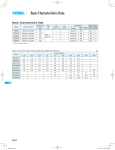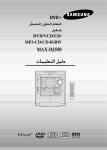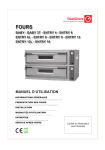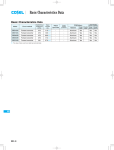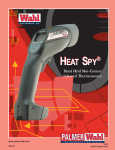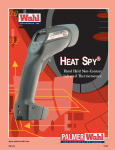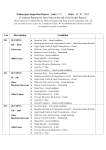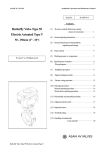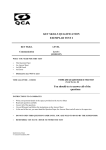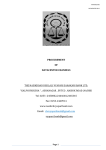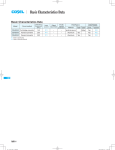Download Basic Characteristics Data
Transcript
Basic Characteristics Data Basic Characteristics Data Model Circuit method Switching frequency [kHz] Input current [A] Rated input fuse DHS50A DHS50B Forward converter 470 *1 DHS100A DHS100B Forward converter 470 DHS200A DHS250B Forward converter 360 *1 Refer to Specification. *2 Refer to Instruction Manual. DHS DHS-14 Series/Parallel operation availability PCB/Pattern Material Single sided - Aluminum *1 - *1 - Double sided Series operation Parallel operation Yes Yes *2 Aluminum Yes Yes *2 Aluminum Yes Yes *2 DC-DC Converters Bus Converter.Power Module Type Instruction Manual 1 Pin Connection DHS-16 2 Connection for Standard Use DHS-16 3 Wiring Input/Output Pin DHS-16 4 5 6 7 3.1 Wiring input pin DHS-16 3.2 Wiring output pin DHS-17 Function DHS-18 4.1 Overcurrent protection DHS-18 4.2 Overvoltage protection DHS-18 4.3 Thermal protection DHS-18 4.4 Remote ON/OFF DHS-18 4.5 Remote sensing DHS-18 4.6 Adjustable voltage range DHS-19 4.7 Withstanding Voltage / Isolation Voltage DHS-20 Series and Parallel Operation DHS-20 5.1 Series operation DHS-20 5.2 Redundancy operation DHS-20 Implementation-Mounting Method DHS-20 6.1 Mounting method DHS-20 6.2 Stress onto the pins DHS-21 6.3 Cleaning DHS-21 6.4 Soldering temperature DHS-21 6.5 Derating DHS-21 6.6 Heat sink(Optional parts) DHS-22 Lifetime expectancy depends on stress by temperature difference DHS-23 DHS-15 DHS DC-DC Converters Bus Converter . Power Module Type 1 Pin Connection 2 Connection for Standard Use ¿DHS50/100 -VIN 3 RC 2 Instruction Manual 6 -VOUT ¡In order to use the power supply, it is necessary to wire as shown in Fig.2.1 and external components in table2.1. 5 TRM ¡Short the following pins to turn on the power module. -VIN RC, +VOUT +S, and -VOUT -S (DHS200/250) 4 +VOUT Reference: 4.4 4.5 +VIN 1 2-FG ”Remote ON/OFF” ”Remote sensing” ¡The DHS Series handles only the DC input. Avoid applying AC input directly. It will damage the power supply. ¿DHS200/250 ¡Operate with the conduction cooling(e.g. heat radiation from the aluminum base plate to the attached heat sink). Reference: 6.5 8 -VOUT ”Derating” -VIN 3 Heatsink 7 -S 6 TRM RC 2 5 +S F1 Cin DC Noise input filter +S +VIN +VOUT Co -VIN +VIN 1 RC 4 +VOUT + CY Load -VOUT FG -S +S, -S : DHS200/250 Fig.2.1 Connection for Standard Use 4-FG Fig.1.1 Pin Connection (bottom view) DHS Table 1.1 Pin Connection and function No. DHS50/100 DHS200/250 1 1 2 2 3 3 4 4 5 6 5 7 8 6 No. DHS50/100 DHS200/250 1 1 2 2 3 3 4 4 5 6 5 7 8 6 DHS-16 Pin Connection +VIN RC -VIN +VOUT +S TRM -S -VOUT Mounting hole Pin Connection +VIN RC -VIN +VOUT +S TRM -S -VOUT Mounting hole Function +DC input Remote ON/OFF -DC input +DC output +Remote sensing Adjustment of output voltage -Remote sensing -DC output Mounting hole Reference 3.1 Wiring input pin 4.4 Remote ON/OFF 3.1 Wiring input pin 3.2 Wiring output pin 4.5 Remote sensing 4.6 Adjustable voltage range 4.5 Remote sensing 3.2 Wiring output pin 6.1 "Mounting hole" No. 1 2 3 4 5 6 Symbol F1 CY Cin Co - Table 2.1 External components component Reference Input fuse 3.1 (1) ”External fuse” Primary decoupling capacitor 3.1 (2) ”Noise filter/ Noise filter Decoupling capacitor” External capacitor on the input side 3.1 (3) ”External capacitor on the input side” External capacitor on the output side 3.2 ”Wiring output pin” Heatsink 6.5 ”Derating” 3 Wiring Input/Output Pin 3.1 Wiring input pin (1) External fuse ¡Fuse is not built-in on input side. In order to protect the unit, install the normal blow type fuse on input side. ¡When the input voltage from a front end unit is supplied to multiple units, install the normal blow type fuse in each unit. Table 3.1 Recommended fuses (Normal-blow type) Model Rated current Model Rated current DHS50A/DHS100A 3.15A DHS50B/DHS100B 1.6A DHS200A 5A DHS250B 3.15A DC-DC Converters Bus Converter . Power Module Type Instruction Manual (2) Noise filter/Decoupling capacitor (5) Operation with AC input ¡Install an external noise filter and a decoupling capacitor CY for low line-noise and for stable operation of the power supply. ¡The DHS series handles only for the DC input. A front end unit(AC/DC unit) is required when the DHS series is ¡Install a correspondence filter, if a noise standard meeting is required or if the surge voltage may be applied to the unit. ¡Install a primary decoupling capacitor CY, with more than 470pF, near the input pins(within 50mm from the pins). ¡When the total capacitance of the primary decoupling capacitor is more than 8800pF, the nominal value in the specification may not operated with AC input. (6) Reverse input voltage protection ¡Avoid the reverse polarity input voltage. It will break the power supply. It is possible to protect the unit from the reverse input voltage by installing an external diode. be met by the Hi-Pot test between input and output. In this case, it is that a capacitor should be installed between output and FG. DC (3) External capacitor on the Input side. YES ¡Install an external capacitor Cin between +VIN and -VIN input pins for low line-noise and for stable operation of the power supply. DHS50A/100A DHS200A DHS Load DHS Load AC DHS50B/100B/250B : more than 0.1 F *When the line inductance is high or ambient temperature is lower than -20C, please increase Cin value more than the AC /DC YES value indicated above. ¡When the line impedance is high or the input voltage rise quickly at start-up(less than 10 s), install a capacitor Cin between +VIN Fig.3.3 Use with AC input (a) (b) and -VIN input pins(within 50mm from pins). +VIN DC IN -VIN DHS50B/100B : more than 10 F : more than 22 F DHS250B Load AC NO : more than 22 F * : more than 47 F * DHS (4) Input voltage range/Input current range +VIN DC IN -VIN Fig.3.4 Reverse input voltage protection ¡The specification of input ripple voltage is shown as below. Ripple voltage DHS50A/100A/200A : less than 10Vp-p DHS50B/100B/250B : less than 20Vp-p ¡Make sure that the voltage fluctuation, including the ripple voltage, will not exceed the input voltage range. ¡Use a front end unit with enough power, considering the start-up current Ip of this unit. 3.2 Wiring output pin DHS ¡Install an external capacitor Co between +VOUT and -VOUT pins for stable operation of the power supply. Recommended capacitance of Co is shown in Table 3.2. ¡Select the high frequency type capacitor. Output ripple and startup waveform may be influenced by ESR ESL of the capacitor and Ripple voltage time t Fig.3.1 Input voltage ripple Input current [A] Input voltage range lp Input voltage range Input voltage [V] the wiring impedance. ¡Install a capacitor Co near the output pins(within 50mm from the pins). Table 3.2 Recommended capacitance Co [ F] Model Output voltage (V) 3.3 5 7.5 12 15 24 28 48 Temparature of Base plate Tbp=0 +100 Tbp=-40 +100 DHS50/100 DHS200/250 DHS50/100 DHS200/250 2200 2200 2200X3 2200X3 2200 2200 2200X3 2200X3 2200 2200X3 470 1000 470X3 1000X3 470 1000 470X3 1000X3 220 470 220X3 470X3 220 470 220X3 470X3 330 330X3 ¡The specified ripple and ripple noise are measured by the method introduced in Fig. 3.5. Input voltage [V] Fig.3.2 Input current characteristics DHS-17 DC-DC Converters Bus Converter . Power Module Type 100mm 2200pF FG 4.4 Remote ON/OFF Measuring board +S ¡The remote ON/OFF function is incorporated in the input circuit and operated with RC and -VIN. +VIN +VOUT DC input Cin + Co RC + C1 Table 4.1 Remote ON/OFF Specifications Load ON/OFF logic -VIN -VOUT FG -S Negative 2200pF Oscilloscope BW:100MHz R Instruction Manual 1.5m 50 Coaxial Cable C R=50 C=0.01 F +S, -S : DHS200/250 Between RC and -VIN L level(0 - 1.2V) or short H level(3.5 - 7.0V) or open Output voltage ON OFF ¡When RC is at low level, a current of 0.5mA typ will flow out. When Vcc is used, keep it within the following rage: 3.5 [ VCC [ 7V. When remote ON/OFF is not used, short RC and -VIN. C1:3.3 - 15V 10 F 24 - 28V 4.7 F 48V 2.2 F Vcc RC RC -VIN Fig.3.5 Method of Measuring Output Ripple and Ripple Noise -VIN Opto coupler RC -VIN 4 Function Transistor RC -VIN IC Relay Fig. 4.1 RC Connection Example 4.1 Overcurrent protection ¡Over Current Protection (OCP) is built in and works at 105% of the rated current or higher. However, use in an over current situation must be avoided whenever possible. The output voltage of the ¿DHS200, DHS250 4.5 Remote sensing (1) When Remote Sensing is Not Used power module will recover automatically if the fault causing over DHS200 DHS250 current is corrected. DHS +S When the output voltage drops after OCP works, the power mod- +VOUT ule enters a ”hiccup mode” where it repeatedly turns on and off at -VOUT -S a certain frequency. 4.2 Overvoltage protection ¡Over Voltage Protection (OVP) is built in. When OVP works, output voltage can be recovered by shutting down DC input for at least one second or by turning off the remote control switch for one second without shutting down the DC input. The recovery + Load Co Short at pin root Fig. 4.2 When Remote Sensing is Not Used (DHS200/250) ¡When remote sensing is not used, make sure +VOUT and +S are shorted, and that -VOUT and -S are shorted as well. ¡Keep the patterns between +S and +VOUT and between -S and -VOUT as short as possible. Avoid a looping pattern. If noise en- time varies according to input voltage and input capacitance. ters the loop, the operation of the power module will become un- Remarks: stable. Note that devices inside the power module may fail when a volt- (2) When Remote Sensing is Used age greater than the rated output voltage is applied from an exter- Wire as close as possible nal power supply to the output terminal of the power module. This could happen in in-coming inspections that include OVP function test or when voltage is applied from the load circuit. OVP can be tested by using the TRM terminal. Consult us for details. 4.3 Thermal protection ¡Over Temperature Protection (OTP) is built in. If the base plate temperature exceeds 100C, OTP will work, causing the output voltage to drop. Output voltage can be recovered by shutting down DC input for at least one second or by turning RC off for one second without shutting down the DC input. DHS-18 DHS200 DHS250 +S +VOUT -VOUT -S + Co Load Fig. 4.3 When Remote Sensing is Used (DHS200/250) ¡Using remote sensing with long wires may cause output voltage to become unstable. Consult us if long sensing wiring is necessary. ¡Sensing patterns or wires should be as short as possible. If wires are used, use either twisted-pair or shielded wires. DC-DC Converters Bus Converter . Power Module Type Instruction Manual ¡Use wide PCB patterns or thick wires between the power module and the load. Line drop should be kept less than 0.3V. Make sure Output +Vout External Resistor R1 output voltage from the power module stays within the specified range. 1 DHS50 DHS100 ¡If the sensing patterns are shorted by mistake, a large current may flow and damage the pattern. This can be prevented by installing TRM 3 Load External Resistor R2 fuses or resistors close to the load. -Vout As wiring or load impedance may generate oscillation or large External VR 1 2 5kW fluctuations in output voltage, make sure enough evaluation is given in advance. Fig. 4.5 Connecting External Devices (DHS50, DHS100) 4.6 Adjustable voltage range Table 4.2 Recommended Values of External Resistors (DHS50, DHS100) ¡Output voltage between +VOUT and -VOUT can be adjusted by connecting external resistors to TRM. ¡When the output voltage adjustment is not used, open the TRM pin respectively. ¡When the output voltage adjustment is used, note that the overvoltage protection circuit operates when the output voltage sets too high. ¡The wiring to the potentiometer should be as short as possible. As the ambient temperature fluctuation characteristics deteriorates depending on the types of resistors and potentiometers used, please use resistors and potentiometers of the following specifica- No. Adjustable Range VOUT±5% VOUT±10% R1 R2 R1 R2 5.1kW 3.3kW 12kW 8.2kW 15kW 10kW 3.3kW 2.2kW 22kW 15kW 39kW 27kW 47kW 33kW Output Voltage 1 2 3 4 5 6 3.3V 5V 12V 15V 24V 28V ¿DHS200, DHS250 tions: (1) Output voltage adjusting Resistors ............. Metal film type, coefficient less than ±100ppm/C Potentiometers ... Cermet type, coefficient less than ±300ppm/C ¡Output voltage can be adjusted by connecting an external potentiometer (VR1) and resistors (R1 and R2) as shown in Fig. 4.6. 5V 120 Others 110 90 0 0 60 Adjustment range [%] Adjustment range [%] ¡When the input voltage is 60 - 66VDC or 200 - 250VDC, the output voltage adjustment range becomes as shown in fig . 4.4. 66 Adjustment range [%] Others 110 100 0 Table 4.3. Consult us if the power module is used in a different configuration. 60 0 0 200 250 Control Amp. of rated voltage 60 66 Input voltage [V] DHS50B, DHS100B - RA 3kW 2.495V TRM 2 + RC 10W R2 -S R1 1 VR1 5kW 3 -VOUT Fig. 4.6 Connecting External Parts (DHS250) Others 110 Table 4.3 Recommended Values of External Resistors (DHS250) No. 60 0 +S RB 3kW 3.3, 5V 120 0 +VOUT DHS200 DHS250 100 100 90 0 Recommended values for external components are shown in Input voltage [V] DHS200A Adjustment range [%] 3.3, 5V Others 110 Input voltage [V] DHS50A, DHS100A 120 5V 120 Output voltage will increase if the resistance between 1 and 2 is reduced by turning the potentiometer clockwise. 200 250 Input voltage [V] DHS250B Fig. 4.4 Output Voltage Adjustment Range ¿DHS50, DHS100 ¡To increase the output voltage, turn the potentiometer clockwise and connect in such a way that the resistance value between 2 1 2 3 4 5 6 7 8 Output Voltage 3.3V 5V 7.5V 12V 15V 24V 28V 48V Adjustable Range VOUT±5% VOUT±10% R1 R2 R1 R2 2.4kW 2.4kW 5.6kW 5.6kW 10kW 10kW 18kW 18kW 12kW 8.2kW 24kW 24kW 43kW 43kW 47kW 47kW 91kW 91kW and 3 becomes small. To decrease the output voltage, turn the potentiometer counterclockwise. DHS-19 DHS DC-DC Converters Bus Converter . Power Module Type Instruction Manual (a) (b) The external resistor (RD) is calculated the following equation. VOD - 0.01 VOR RD= [kW] VOD 1.0 VOR 1.51X DHS200 +VOUT DHS250 +S VOR :Rated output voltage[V] VOD :Output voltage needed to set up[V] TRM Load Power Supply Power Supply Power Supply Load ¡By connecting the external resistor (RD), output voltage becomes adjustable to decrease. Load (2) Output voltage decreasing Power Supply Fig. 5.1 Examples of series operation 5.2 Redundancy operation ¡Parallel operation is not possible. ¡Redundancy operation is available by wiring as shown below. RD -S -VOUT +S +VOUT Fig. 4.7 Connection for output voltage decreasing (DHS200/250) +S +VOUT The external resistor (RU) is calculated the following equation. [ 3.0X DHS200 +VOUT DHS250 +S TRM VOR VOU + 0.01 - 1.51 X Vref VOR VOU - 1.0 VOR -S -VOUT DHS I2 -VOUT -S ] VOR :Rated output voltage [V] VOU :Output voltage needed to set up [V] Vref :Refarence voltage [V] Vref=2.495 [V] Load ¡By connecting the external resistor (RU), output voltage becomes adjustable to increase. RU I3 -VOUT -S (3) Output voltage increasing RU= I1 +S, -S : DHS200/250 Fig. 5.2 Example of Redundancy Operation ¡Even a slight difference in output voltage can affect the balance between the values of I1 and I2. Please make sure that the value of I3 does not exceed the rated current of a power supply. I3 the rated current value Fig. 4.8 Connection for output voltage increasing (DHS200/250) 4.7 Withstanding Voltage / Isolation Voltage ¡When testing the withstanding voltage, make sure the voltage is increased gradually. When turning off, reduce the voltage gradual- 6 ImplementationMounting Method ly by using the dial of the hi-pot tester. Do not use a voltage tester with a timer as it may generate voltage several times as large as the applied voltage. 6.1 Mounting method ¡The unit can be mounted in any direction. When two or more power supplies are used side by side, position them with proper 5 Series and Parallel Operation intervals to allow enough air ventilation. Aluminum base plate temperature around each power supply should not exceed the temperature range shown in derating curve. ¡Avoid placing the DC input line pattern lay out underneath the unit, it will increase the line conducted noise. Make sure to leave an ample distance between the line pattern lay out and the unit. Also 5.1 Series operation ¡Series operation is available by connecting the outputs of two or more power supplies, as shown below. Output current in series connection should be lower than the lowest rated current in each unit. avoid placing the DC output line pattern underneath the unit because it may increase the output noise. Lay out the pattern away from the unit. ¡High-frequency noise radiates directly from the unit to the atmosphere. Therefore, design the shield pattern on the printed circuit board and connect its one to FG. The shield pattern prevents noise radiation. DHS-20 DC-DC Converters Bus Converter . Power Module Type Instruction Manual Shield pattern -VOUT TRM -VOUT +VOUT -VIN RC +VIN +VOUT -VIN DHS50, DHS100 +VIN -VOUT -VIN DHS50, DHS100 -S Shield pattern TRM RC +S +VIN +VOUT -VOUT -VIN DHS200, DHS250 +VOUT, -VOUT +VOUT +VIN Less than 39.2N(4kgf) Less than 39.2N(4kgf) Others Less than 19.6N(2kgf) Less than 39.2N(4kgf) Less than 19.6N(2kgf) Less than 19.6N(2kgf) Fig. 6.2 Stress onto Pins DHS200, DHS250 Fig. 6.1 Shield pattern lay out (bottom view) 6.2 Stress onto the pins ¡Applying excessive stress to the input or output pins of the power module may damage internal connections. Avoid applying stress in excess of that shown in Fig. 6.1. ¡Input and output pins are soldered onto the internal PCB. Do not bend or pull the leads with excessive force. ¡As unexpected stress may be applied to the pins, set the diameter of the PCB mounting hole at 3.5mm. ¡As unexpected stress may be applied to the pins from vibration or shock, fix the power module by using the mounting holes with screws to reduce stress. ¡Fix the power module to the PCB with the screws before soldering the input and output pins to prevent the PCB pattern being damaged. 6.3 Cleaning DHS ¡Clean the soldered side of the power module with a brush. Prevent liquid from getting into the power module. Do not clean by soaking the power module into liquid. ¡Do not allow solvent to come in contact with product labels or resin cases as this may change the color of the resin case or cause deletion of the letters printed on the product label. ¡After cleaning, dry the power modules well. 6.4 Soldering temperature ¡Flow soldering: 260C for up to 15 seconds. ¡Soldering iron (26W): 450C for up to 5 seconds. 6.5 Derating ¡Use the power modules with conduction cooling (e.g. heat dissipation from the aluminum base plate to the attached heat sink). Fig. 6.3 shows the derating curves with respect to the aluminum base plate temperature. Note that operation within the hatched areas will cause a significant level of ripple and ripple noise. ¡Please measure the temperature on the aluminum base plate edge side when you cannot measure the temperature of the center part of the aluminum base plate. In this case, please take 5deg temperature margin from the derating characteristic of Figure 6.3. DHS-21 DC-DC Converters Bus Converter . Power Module Type ¡It is necessary to note the thermal fatigue life by power cycle. Please reduce the temperature fluctuation range as much as possible when the up and down of the temperature are frequently generated. Instruction Manual 6.6 Heat sink(Optional parts) ¿DHS50, DHS100 ¡The power module works with conduction cooling and needs heat dissipation using heat sinks. Optional heat sinks are available for Contact us for more information on cooling methods. ¿DHS50, DHS100 DHS Series. Refer to Table 6.1 and Table 6.2 for details on the thermal resistance of heat sinks. 2 1 Table 6.1 Types of Heat Sinks Available 1DHS100B24,28 2Others Size[mm] 50 -20 0 20 40 60 (85) 80 100 110 Aluminum base plate temperature Tc [C] ¿DHS200 1 2 3 4 5 6 F-QB-F1 F-QB-F2 F-QB-F3 F-QB-F4 F-QB-F5 F-QB-F6 H W D 12.7 12.7 25.4 25.4 38.1 38.1 58.4 58.7 58.4 58.7 58.4 58.7 37.6 37.3 37.6 37.3 37.6 37.3 W 100 -20 0 20 60 (75) (85) 80 100 110 ¿DHS250 Fig.6.4 Heat Sink Types 2 1DHS250B12,48 2Others -20 0 20 40 10 1 50 60 (75) (85) 80 100 110 Aluminum base plate temperature Tc [C] Tc Measuring point Thermal resistance(C/w) Load factor [%] Vertical Horizontal 100 15 0 -40 5.0 D 40 Aluminum base plate temperature Tc [C] DHS 7.5 Horizontal Vertical Horizontal Refer Fig.6.5 Vertical Horizontal Vertical 2 50 15 0 -40 14.0 Style W 1 1DHS200A05 2Others Thermal resistance[C/W] Convection Forced Air (0.1m/s) H Load factor [%] Model D 15 0 -40 No. H Load factor [%] 100 8 F-QB -F1/F2 F-QB -F3/F4 F-QB -F5/F6 6 4 2 0 0.0 0.5 1.0 1.5 2.0 Wind velocity(m/s) 2.5 Fig.6.5 Thermal Resistance of Heat Sink(Forced Air) DHS50, DHS100 DHS200, DHS250 Fig.6.3 Derating Curve DHS-22 3.0 DC-DC Converters Bus Converter . Power Module Type ¿DHS200, DHS250 Table 6.2 Types of Heat Sinks Available Size[mm] No. Model 1 2 3 4 5 6 F-CBS-F1 F-CBS-F2 F-CBS-F3 F-CBS-F4 F-CBS-F5 F-CBS-F6 H W D 12.7 12.7 25.4 25.4 38.1 38.1 57.9 58.4 57.9 58.4 57.9 58.4 61.5 61.0 61.5 61.0 61.5 61.0 Thermal resistance[C/W] Convection Forced Air (0.1m/s) 7.5 4.6 3.0 Style Horizontal Vertical Horizontal Refer Fig.6.7 Vertical Horizontal Vertical W Instruction Manual 7 Lifetime expectancy depends on stress by temperature difference ¡Regarding lifetime expectancy design of solder joint, following contents must be considered. It must be careful that the soldering joint is stressed by temperature rise and down which is occurred by self-heating and ambient temperature change. The stress is accelerated by thermal-cycling, therefore the tem- W perature difference shoud be minimized as much as possible if temperature rise and down is occurred frequently. D D ¡Product lifetime expectancy depends on the aluminum base plate central temperature difference (DTc) and number of cycling in a day is shown in Fig.7.1. If the aluminum base plate center part temperature changes frequently by changing output load factor etc., the above the lifetime expectancy design should be applied as well. Vertical Fig. 6.6 Heat Sink Types Thermal resistance(C/w) 6 5 F-CBS-F1/F2 F-CBS -F3/F4 F-CBS-F5/F6 4 3 Lifetime expectancy [years] Horizontal H H Please contact us for details. 10 5 1time 2times 3times 4times 5times ON/OFF /1day ON/OFF /1day ON/OFF /1day ON/OFF /1day ON/OFF /1day DHS 0 25 30 35 40 45 50 55 60 65 70 The aluminum base plate central temperature differenceDTc [C] Fig7.1 Lifetime expectancy against rise/fall temperature difference 2 1 0 0.0 0.5 1.0 1.5 2.0 Wind velocity(m/s) 2.5 3.0 Fig.6.7 Thermal Resistance of Heat Sink(Forced Air) DHS-23










